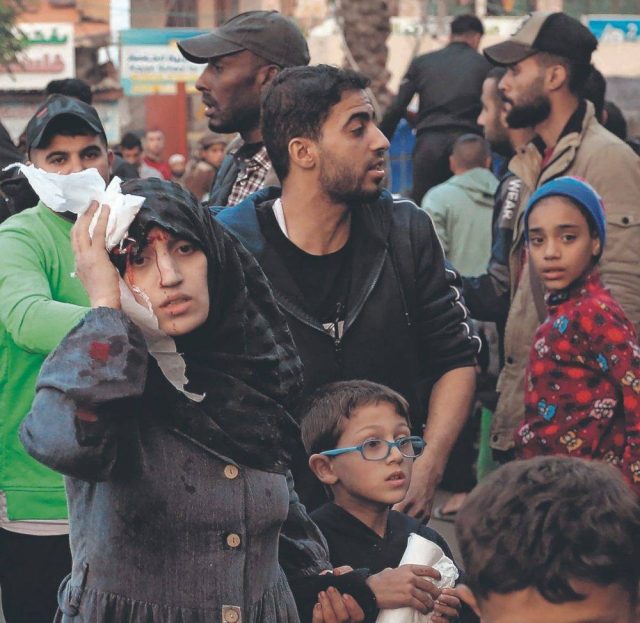

The war in Gaza has resurrected an old debate — when is organised political violence a legitimate struggle against entrenched injustice and when is it terrorism?
The issue surfaced in South Africa after the ANC took up arms. In the late 1980s, Britain’s prime minister Margaret Thatcher publicly denounced it — and implicitly its leaders, including Nelson Mandela — as “a typical terrorist organisation”.
Israeli “hasbara” (propaganda) has systematically portrayed violent resistance to its 56-year occupation of Palestine as anti-Semitic terrorism. The West has limply followed suit — the EU has adopted the “terrorist” designation, while Hamas was proscribed as a foreign terrorist movement by the US in 1997 and its military wing by Britain in 2001.
The terminological differences largely reflect geopolitical and religious solidarity. China and Russia have refused to condemn Hamas, as have regional players Qatar, Saudi Arabia, Syria and Iran.
This a touchy issue for the media. In the interests of journalistic neutrality, the BBC has eschewed the term “terrorist”, drawing fire from Israel and across mainstream politics.
The dictionary defines “terrorism” as the use of violence or threats to intimidate or coerce, especially for political purposes, suggesting it does not cover hate crimes and random violence by individuals without a realisable vision or programme.
Hamas is not a flash in the pan or fever dream. It is a formally constituted political party of 25 000 members, with a 15-member politburo led by a president, Ismail Haniyeh, and a separate military wing, the Al-Qassam Brigades. In Gaza’s 2006 legislative elections it ousted the older nationalist movement, Fatah, as corrupt and too close to Israel after it renounced violence, and now rules Gaza’s two million inhabitants.
Touted as the sole bastion of democracy in the Middle East, Israel reacted to voters’ exercise of their democratic right to choose by imposing a 16-year blockade of Gaza’s airspace, coastline and, with Egypt, borders. To no avail — a recent survey indicates that, after 7 October, 72% of Palestinians continue to support Hamas.
Founded by a Muslim cleric, its inaugural manifesto, the Hamas Covenant, was an old-fashioned messianic document whose slogan declared: “Allah is the target, the Prophet the model, the Quran the path and death for the sake of Allah the loftiest of causes.” It rejected the secular socialism of Fatah, which administers parts of the West Bank.
The Covenant called for the “obliteration” of Israel, casting even this in religious language: Palestine was described an Islamic endowment (waqf) and both Christianity and Judaism were enjoined to submit to the supremacy of Islam in the region.
In places it descended into crude anti-Semitism, citing the Protocols of the Elders of Zion as evidence of a Jewish plan for world domination and predicting the Day of Judgment would not dawn until “Muslims fight the Jews (killing the Jews)”, who “will hide behind stones and trees”.
Exploiting this document, and knowing the widespread revulsion Islamic State provokes, Israeli premier Benjamin Netanyahu has repeatedly tried to tar Hamas with the Islamic State brush. After the 7 October raid, he again made the connection, saying: “Just as the forces of civilisation united to defeat Isis, the forces of civilisation must support Israel in defeating Hamas.”
In reality, the two organisations have different roots and aims. Islamic State, which sees itself as waging an international holy war against unbelievers — as distinct from Hamas’ exclusive focus on Gaza — is a movement of almost medieval cruelty.
In 2022, Amnesty International reported that Hamas had resumed executions in Gaza after a five-year hiatus. But the party does not decapitate its opponents on the internet, amputate limbs for smoking and theft, drive religious and ethnic minorities into the wilderness or sell female captives into sexual slavery.
In 2017, it released the “Revised Hamas Charter”, praised for its pragmatism, which recast Hamas’ programme as one of national liberation, rather than religious crusade, and asserted its quarrel was not with Jews but the Zionist enterprise.
“Hamas rejects the persecution of anyone and the undermining of his or her rights,” the Charter says, arguing — correctly — that anti-Semitism had been “a phenomenon fundamentally linked to European history”.
Although it called Israel an “illegal entity”, and remained committed to armed struggle, the charter called for a Palestinian state along the “Green Line”, the unofficial boundary of the Occupied Territories. Any peace deal endorsed by all Palestinians, including in the Diaspora, would be accepted.
Netanyahu’s reaction was entirely predictable. Instead of testing whether the revised document might be a move towards resolving the world’s most intractable conflict, he dismissed it as a stunt and tossed it in a bin in front of TV cameras.
Israel likes to complain that it has no partner for dialogue but Netanyahu’s antics made it clear that he has no interest in making peace or negotiating Palestinian statehood.
Like a boa constrictor, Israel’s aim is gradually to digest the Occupied Territories while spitting out its Palestinian residents to ensure “demographic balance”. To achieve this, it has encouraged the expansion of close to 370 illegal Israeli settlements in the West Bank and East Jerusalem.
Settlers — there are 700 000 of them — have terrorised the Palestinians with virtual impunity, corralling them into shrinking islands.
Judged by its programme, then, Hamas is not the terrorist ogre of Israel’s fantasies. It wants to abolish the State of Israel but it is not alone in thinking Zionism has failed and a unitary state is the only solution.
Of course, Al-Qassam committed war crimes against non-combatants on 7 October but Jewish settlers and their meat-grinding armed wing the Israel Defence Forces (IDF) have done the same on a far larger scale for a century.
The Jewish Virtual Library records at least 90 000 Palestinian/Arab deaths at Jewish/Israeli hands in at least 18 wars and lesser conflicts since 1920, a disproportionate rate of 22:1. The current onslaught in Gaza has been relatively restrained by Israeli standards — the comparative kill rate is 16:1, with women and children about half the Palestinian dead.
Then there is the argument that “Hamas started the fight”, which depends on how far back one looks.
Israel has refused to concede any context for the raid. When UN secretary general António Guterres remarked 7 October “did not take place in a vacuum”, its spin machine accused him of siding with Hamas and called for his resignation.
Can one really believe the crippling blockade of Gaza, punctuated by five major military operations, has not stoked hatred of Israel? The Israelis must think the Gazans are saints!
What of the ruthless ethnic purging of Palestine in 1948 under David Ben-Gurion’s Plan Dalet, documented in painful detail by the Israeli historian Ilan Pappe and others? Marked by massacres, expulsions and the destruction of more than 500 villages, the cleansing was followed by a refusal to allow 750 000 Palestinians to return to their country, homes and fields.
What of the villagers of Tantura, executed and now buried under a car park? Of Haifa, where Palestinians, trampling each other in terror, were stampeded into the sea by Israeli mortar fire?
It is no coincidence communal violence in Palestine starts in the 1920s, with the first large-scale influx of Jewish settlers from Europe. Through intrusion and dispossession, the Jewish presence grew from about 24 000 — less than 5% of the population — end-19th century to 600 000 in 1948 and now nine million.
Israel’s bravest journalist, Haaretz’s Gideon Levy, remarks that Israelis have the deluded belief that the IDF is the world’s most moral army. In fact, its forebears, Haganah and the assassins and bombers of the Stern Gang and Irgun were merciless in 1948, and not much has changed.
A sample from the week before Christmas: on 15 December, IDF forces mistakenly killed three hostages waving a white flag, strongly suggesting that they execute fighters seeking to surrender, a war crime.
On the same day, Doctors Without Borders says, they shot dead an unarmed teenager in the grounds of the Khalil Suleiman Hospital on the West Bank and blocked ambulances transporting the seriously wounded.
Human Rights Watch accused IDF members of using civilian starvation “as a weapon of war” by thwarting the delivery of food, water and fuel to Gaza and razing agricultural land.
On 17 December the French government, an Israeli ally, complained that an airstrike on a house in Rafah had killed “many” civilians, including one of its staff members.
It was a week in which Pope Francis excoriated the IDF for terrorism “after a sniper killed two Christian women in a Gaza church complex”.
“If we want to stay alive, we have to kill, kill and kill. All day, every day …” Pappe quotes Israeli academic Arnon Soffer as writing in Haaretz in 2004.
Indeed, the Zionist project has been inherently violent from the outset.
What drives the spiralling genocidal madness in Gaza is not so much the atrocities of 7 October as the cause in which they were committed — Hamas’ refusal to accept the legitimacy of the State of Israel.
Drew Forrest is a former political editor and deputy editor of the Mail & Guardian.
Amid Israel’s increasingly unhinged siege of the enclave, Drew Forrest probes the country’s claim that it is fighting a war against terror




